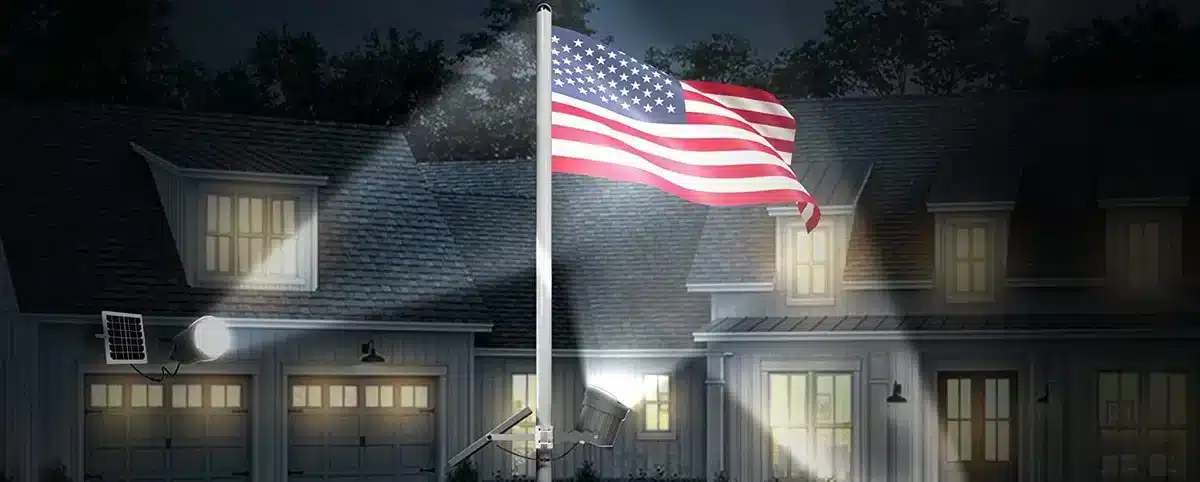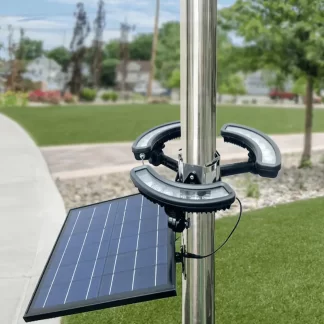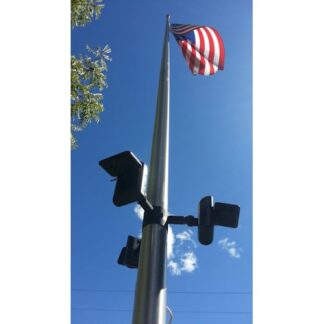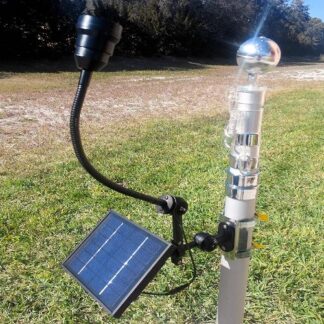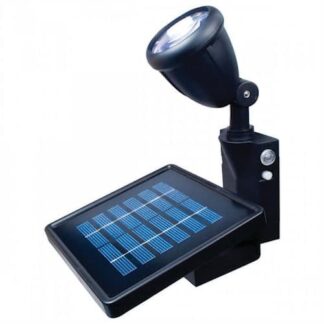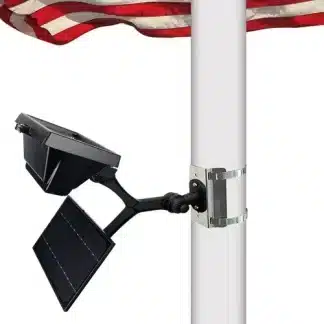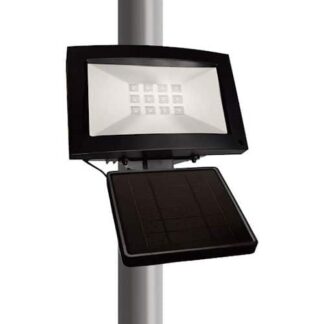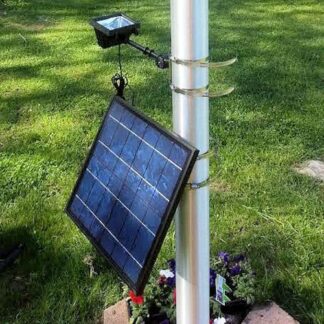Illuminate Your Allegiance: A Comprehensive Guide to Solar Flagpole Lights
Hey there, light enthusiasts! Are you ready to dive into the world of Solar Flagpole Lights? You’ve come to the right place. We’re about to embark on a thrilling journey to explore the ins and outs of these eco-friendly, cutting-edge solar lights that’ll make your flag shine like a beacon at night. Buckle up, and let’s get illuminated! Continue reading.
The Unrivaled Champion: Our Best Seller
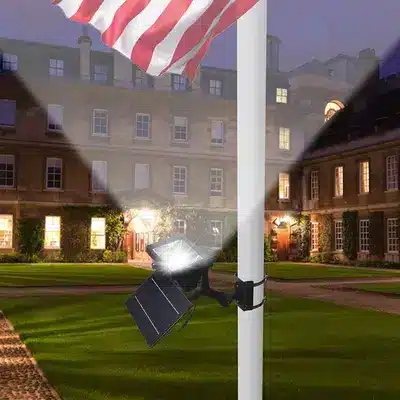
Flag Illumination Fusion: Merging Solar Flagpole Lights with Your Star-Spangled Passion
Picture this: you’ve proudly hoisted your flag outside your home or office, a testament to your unwavering dedication. But there’s a twist! Flag etiquette has a few tricks up its sleeve, and if you’re not keen on hoisting and lowering your banner daily, a solar flagpole light is your ultimate ally. So, let’s embark on a rad adventure to uncover the secrets of selecting the perfect solar flagpole light to keep your emblem shining day and night, powered by the sun’s eternal embrace.
Solar Flagpole Lights – The Future of Flag Illumination
Solar flagpole lights are the ultimate solution to nighttime flag illumination and to keep Old Glory or your favorite team’s banner in the spotlight. These energy-efficient, low-maintenance marvels are perfect for patriots and environmentalists alike.
Illuminating Spaces: Versatile Venues for Solar Flagpole Lights to Shine Bright
Solar flagpole lights are incredibly versatile and can be used in various locations to showcase flags with pride and style. Here are some places where you can install these eco-friendly illuminators:
- Residential Properties: Homeowners who want to display national, state, or personal flags in their front yards, gardens, or backyards can benefit from flagpole solar lights. They provide a striking nighttime display and add a touch of elegance to your property.
- Commercial Buildings: Businesses and offices can use solar flagpole lights to illuminate corporate, national, or other relevant flags. These lights highlight the company’s pride and values and serve as a welcoming beacon to visitors and clients.
- Schools and Universities: Educational institutions can use solar flag illumination to showcase their school’s emblem or flag, fostering a sense of pride and unity among students, faculty, and staff.
- Government Buildings: Local, state, and federal government offices can use solar flag lights to illuminate their flags, signifying the authority and commitment to public service.
- Parks and Recreational Areas: Solar flagpole lights can be installed in public parks, sports arenas, or other recreational facilities to showcase flags representing the community, city, or sports teams.
- Military Bases: Military installations can use solar flag lights to honor their respective service branches and display their commitment to the nation’s defense.
- Historical Sites and Monuments: Solar flag illumination can be used at historical landmarks, memorials, or monuments to illuminate flags associated with the site, paying tribute to the history and heritage they represent.
- Cemeteries: Veteran cemeteries or memorial parks can use solar flagpole lights to honor fallen heroes and their service to the nation by illuminating the flags at these sites.
Sunlit Scenes: A Journey Through Iconic Locations Illuminated by Solar Flagpole Lights
- Liberty State Park, New Jersey: This park, located on the Hudson River waterfront, boasts an impressive view of the Statue of Liberty, Ellis Island, and the Manhattan skyline. Flagpole solar lights are used to illuminate the U.S. flag and the New Jersey state flag, adding to the park’s patriotic ambiance.
- The University of California, Santa Barbara: The campus of this esteemed institution showcases solar flagpole lights to illuminate the flags of the United States, the state of California, and the university itself. These lights help to promote school pride and environmental responsibility.
- City Hall, San Diego, California: The San Diego City Hall employs solar flag lights to keep the American and Californian flags shining brightly throughout the night. This demonstrates the city’s commitment to sustainability and adds a welcoming touch to the government building.
- NASA Kennedy Space Center Visitor Complex, Florida: As a symbol of innovation and exploration, the Kennedy Space Center Visitor Complex uses solar flagpole lights to illuminate the U.S. and NASA flags. This helps to create a sense of unity and pride among visitors and staff.
- Arlington National Cemetery, Virginia: This iconic military cemetery honors fallen heroes with solar flag illumination, ensuring that the flags displayed throughout the grounds are illuminated with respect and dignity.
These real-world examples demonstrate the versatility and effectiveness of solar flagpole lights across various locations and settings, highlighting their importance in creating memorable and eco-friendly flag displays.
Remember, when installing solar flag lights, always ensure that the solar panels receive ample sunlight for efficient energy conversion and consistent illumination.
Solar Flagpole Lights: A Diverse Array of Luminous Options
Ready to explore the fascinating world of solar flagpole lights? A dazzling variety of options is available, each designed to meet specific needs and preferences. Check out these different types of solar flag lights:
- Top-Mounted Solar Lights: These lights are installed at the top of the flagpole, directly beneath the finial. They cast a downward glow, ensuring your flag is evenly illuminated from top to bottom. Top-mounted solar lights are discreet and provide focused lighting without affecting the surroundings.
- Side-Mounted Solar Lights: Side-mounted solar lights attach to the middle or upper section of the flagpole, shining their light upward or downward, depending on the design. They’re easy to install and maintain, and the adjustable angle allows customized lighting.
- Ground-Mounted Solar Lights: Installed at the flagpole’s base, these lights shine upwards, bathing the flag in a bright, dramatic display. Ground-mounted solar lights are independent of the flagpole, making them easy to adjust and maintain. They also offer the added benefit of landscape lighting.
- Solar Spotlights: Solar spotlights can be placed on the ground or mounted on a nearby structure, shining their focused beam on the flag. They offer versatility in installation and provide a striking, theatrical illumination effect.
- All-in-One Solar Flagpole Lights: These units feature a solar panel, light, and battery, all housed within a single unit, making them compact and easy to install. Depending on the design, they can be mounted on the flagpole or the ground.
- Multi-Functional Solar Flag Lights: Some Flagpole solar lights have additional features, such as color-changing LEDs or dual lighting modes (e.g., steady or flashing). These options allow you to customize your flag illumination and create unique displays.
- Solar Floodlights: These powerful lights emit a broad, intense beam of light, making them an excellent choice for illuminating larger flags or multiple flags simultaneously. Solar floodlights can be placed on the ground or mounted on a nearby structure, and they often feature adjustable angles for precise lighting. They’re an energy-efficient solution for creating a dramatic and eye-catching flag display while providing additional security and landscape lighting.
Now that you’re well-versed in the various types of solar flagpole lights, you can choose the perfect option to suit your needs and let your flag shine with pride and eco-friendly radiance!
Solar Flagpole Lights: A Spectacular FAQ Odyssey
Embark on an epic quest to uncover the mysteries of solar flagpole lights! Explore this cool FAQ to satisfy your curiosity and become a solar illumination master.
Solar flag lights absorb sunlight through their solar panels during the day, converting it into electricity. This energy is stored in rechargeable batteries and used to power LED lights when darkness falls. No wiring or external power source is needed, making these lights eco-friendly and energy-efficient.
Absolutely! Most flagpole solar lights are designed to withstand various weather conditions, including rain, snow, and wind. Look for models with durable materials and waterproof ratings for optimal performance.
LED lights typically have a lifespan of 25,000 to 50,000 hours, while solar panels can last 15-20 years or more. With proper care and maintenance, your solar flagpole light will shine brilliantly for years to come.
Most solar flag lights are designed to fit a variety of flagpole sizes and styles. However, it’s essential to verify compatibility with your specific flagpole before purchasing. Adjustable mounting options and universal brackets can help ensure a perfect fit.
Minimal maintenance is required for flagpole solar lights. Keep the solar panels clean and free from debris to ensure optimal sunlight absorption. Additionally, replace rechargeable batteries every 1-2 years to maintain peak performance.
Yes! There are solar flagpole light options designed specifically for larger flags. Look for models with a higher number of LED lights and greater brightness output to make your large flag shine bright.
Now that you’ve traversed the spectacular FAQ odyssey, you’re equipped with the knowledge to confidently explore the world of solar flag illumination. Go forth and light up the night sky with pride and eco-conscious flair!
Exploring the Pros and Cons of Solar Flagpole Lights
While solar flag illumination offers numerous benefits, it’s essential to consider the potential drawbacks before making a decision. Here are some pros and cons to keep in mind:
Pros
- Energy Efficiency: Solar flagpole lights harness the sun’s energy, making them a cost-effective and environmentally friendly alternative to traditional lighting. You’ll save money on electricity bills while contributing to a greener planet.
- Easy Installation: Solar flag lights are usually straightforward to install without complicated wiring or electrical connections. This ease of installation makes them an attractive option for DIY enthusiasts or those looking to avoid the cost of hiring a professional electrician.
- Low Maintenance: Solar lights for flagpoles require minimal upkeep. Apart from occasionally cleaning the solar panels and replacing the rechargeable batteries, these lights are virtually maintenance-free.
- Automatic Operation: Many solar flagpole lights come with built-in light sensors or timers that automatically turn the lights on at dusk and off at dawn. This feature eliminates the need for manual intervention and ensures your flag is always properly illuminated.
- Safety: Solar flagpole lights are safe and pose no risk of electric shock or fire hazards. Since they rely on solar energy, there are no cords or wires that could pose a tripping hazard or be damaged by weather or rodents.
- Versatility: In addition to their primary purpose of illuminating flags, some solar flagpole lights can also function as landscape or security lighting, adding an extra layer of functionality to their eco-friendly charm.
- Customization: Many solar flagpole lights offer adjustable brightness levels, lighting angles, or color options, allowing you to personalize your flag illumination experience.
- Independence from Grid: Solar flagpole lights operate independently of the electrical grid, ensuring your flag remains illuminated even during power outages or in remote locations without access to electricity.
Cons
- Initial Cost: Solar flagpole lights may have a higher upfront cost compared to traditional flagpole lights. However, they can offset this cost with energy savings over time, as they require no additional power from the grid.
- Sunlight Dependency: The performance of solar flagpole lights relies heavily on the availability of sunlight. If your location experiences long periods of overcast skies or minimal sun exposure, the lights may not charge effectively, resulting in decreased brightness or shorter operating times.
- Battery Replacement: Solar flag lights rely on rechargeable batteries to store energy. Over time, these batteries may lose their ability to hold a charge, requiring replacement every 1-2 years, depending on the specific model.
- Limited Brightness: Although advancements in solar and LED technology have significantly improved the brightness of solar flagpole lights, they may not be as powerful as electric lights. This could be a concern if you require exceptionally bright illumination for your flag.
- Temperature Sensitivity: Solar flag lights may have reduced efficiency in extreme temperatures. Cold weather can decrease the batteries’ ability to hold a charge, while high temperatures might lead to increased energy loss from the solar panels.
- Less Control: Some solar flagpole lights may not offer the same level of control as traditional flagpole lights. For example, not all models have adjustable brightness or the ability to switch the light on and off manually.
By considering both the pros and cons, you can make an informed decision about whether solar flagpole lights are the right choice for your flag illumination needs. Despite their potential drawbacks, these lights remain a popular, eco-friendly option for many flag enthusiasts.
Essential Tips and Tricks for Solar Flagpole Light Success
To ensure you get the most out of your solar flagpole light, follow these essential tips and tricks to maximize performance, longevity, and visual impact:
- Optimal Solar Panel Positioning: Ensure the solar panel is positioned to receive maximum sunlight throughout the day. This may require angling the panel towards the sun or avoiding shaded areas. Proper positioning will optimize charging and result in longer and brighter illumination.
- Choose the Right Model: Consider the size of your flag, flagpole height, and surrounding environment when selecting a solar flagpole light. Opt for a model with the appropriate brightness, mounting options, and features to suit your needs.
- Regular Cleaning: To maintain optimal performance, keep the solar panel clean and free from dirt, dust, and debris. A clean solar panel will absorb more sunlight, leading to better charging and longer-lasting illumination.
- Battery Maintenance: Monitor the performance of your solar flagpole light’s rechargeable batteries. Replace them as needed (usually every 1-2 years) to ensure the light continues functioning at peak efficiency.
- Proper Installation: Follow the manufacturer’s guidelines when installing your solar flagpole light. Secure all components to prevent wind or weather damage and ensure the light is positioned correctly for maximum illumination.
- Flag Material: Opt for a lightweight, durable flag material that will flutter gracefully in the wind and not weigh down the flagpole. This will prevent the flag from obscuring the light and ensure it remains visible at night.
- Observe Local Regulations: Always check your local flag etiquette and lighting ordinances to ensure your solar flagpole light meets specific requirements.
- Monitor Weather Conditions: Solar flagpole lights are generally designed to withstand various weather conditions, but it’s wise to watch extreme weather events that may impact the light’s performance. Remove the light during severe storms or heavy snowfall to prevent damage.
- Consider Backup Lighting: In areas prone to extended overcast periods or limited sun exposure, consider having a backup solar flagpole light or alternative lighting source to ensure your flag remains illuminated during less-than-ideal charging conditions.
By following these essential tips and tricks, you can set yourself up for solar flagpole light success, proudly displaying your flag in a brilliant, eco-friendly manner.
Keep the Light Shining: Troubleshooting Your Solar Flagpole Light
Occasionally, solar flagpole lights may experience issues that impact their performance. Here’s a guide to help you troubleshoot and resolve common problems to keep your flag illuminated:
- Dim or Flickering Light: If your solar flagpole light is dim or flickering, first check the cleanliness of the solar panel. Dirt or debris can reduce the panel’s efficiency and impact the light’s brightness. If cleaning doesn’t resolve the issue, inspect the rechargeable batteries. Weak or old batteries may need replacing.
- Light Not Turning On: If your solar flagpole light isn’t turning on, ensure the solar panel has been receiving adequate sunlight. Inadequate sunlight exposure can result in insufficient charging. If the panel is positioned correctly, inspect the batteries for possible replacement. Also, ensure any power switches or buttons are in the correct “On” position.
- Light Not Turning Off: If your solar flagpole light remains on during daylight hours, the light sensor may malfunction or be obstructed. Ensure the sensor is clean and unobstructed. If the issue persists, you may need to contact the manufacturer for assistance or replacement.
- Inconsistent Operation: If your solar flagpole light operates inconsistently, first verify that the solar panel is optimally positioned for sunlight exposure. Next, check the light sensor for possible obstructions or dirt. If neither of these factors is causing the issue, inspect the batteries for potential replacement.
- Damage from Weather or Wildlife: If your solar flagpole light has been damaged by severe weather or wildlife, assess the extent of the damage. You can perform a simple repair for minor damage, such as a loose component or bent bracket. However, if the damage is significant or affects the solar panel or LED lights, you may need to contact the manufacturer or purchase a replacement.
- Reduced Performance in Extreme Temperatures: If your solar flagpole light is experiencing reduced performance during extremely hot or cold weather, consult the manufacturer’s guidelines for temperature specifications. Some models may have reduced efficiency in extreme temperatures, and you may need to consider an alternative light designed for such conditions.
By following this troubleshooting guide, you can identify and resolve common issues with your solar flagpole light, ensuring it continues to keep your flag proudly illuminated night after night.
Light Up the Legal Way: Flag Illumination and the Law, Unraveled
Hey there, flag aficionados! When it comes to flag illumination, the law has your back. In the U.S., the Flag Code provides guidelines for displaying the Stars and Stripes, suggesting that Old Glory should be illuminated during nighttime. You’re not only encouraged to light up your flag, but you’re also a stellar patriot while doing so.
So, let’s get lit – the legal way! By choosing solar flagpole lights, you’re abiding by the law and showing love to Mother Earth. Shine on, eco-warriors, and let your flags fly high in the night sky, backed by the power of the sun and the force of the law!
Navigating the Legal Labyrinth: Solar Flagpole Lights and the Law
Fear not, eco-conscious flag enthusiasts! Solar flagpole lights are generally embraced as a legal and environmentally friendly way to illuminate your beloved banners. However, it’s always wise to double-check your local regulations, as some areas may have specific ordinances governing outdoor lighting or flag displays.
Don’t let it dim your enthusiasm in the rare event you encounter red tape. Remember, you’re at the forefront of a green revolution, championing a sustainable alternative to traditional flagpole lights. Let your solar spirit soar, and illuminate the path to a brighter, more eco-conscious world!
Flying High and Bright: A Guide to Lighting Your Flagpole
Lighting a flagpole ensures that your flag remains visible and adequately displayed even after the sun goes down. Here’s a step-by-step guide on how to light a flagpole effectively:
- Choose the right type of light: Select the most suitable lighting option for your needs, such as solar flagpole lights, electric flagpole lights, low-voltage LED lights, or battery-powered lights. Consider factors like energy efficiency, installation complexity, and maintenance requirements.
- Select the appropriate brightness: Ensure your light is powerful enough to illuminate your flag without causing glare or light pollution. Opt for a light with adjustable brightness levels to customize the illumination according to your preferences.
- Position the light correctly: The light should be positioned to cast light evenly across the entire flag without creating dark spots or shadows. You can mount the light at the flagpole’s base shining upward, attach it directly to the flagpole facing downward, or use a combination of lights to achieve the desired effect.
- Follow flag etiquette: Familiarize yourself with flag etiquette, including the U.S. Flag Code, which requires flags displayed at night to be appropriately illuminated. Ensure your flagpole lighting adheres to these guidelines.
- Install the light: Follow the manufacturer’s instructions for installing the light. Installation is usually straightforward for solar and battery-powered lights and may not require professional assistance. Electric and low-voltage lights will require wiring and may need the help of an electrician.
- Set up automatic operation: If your light has a built-in sensor or timer, set it up to automatically turn on at dusk and off at dawn. This will ensure your flag is always illuminated during nighttime hours without manual intervention.
- Perform regular maintenance: Keep the light clean and in good working order. For solar lights, clean the solar panel regularly to ensure optimal charging. Replace batteries as needed and monitor the light’s performance to identify any issues.
By following these steps, you can successfully light your flagpole, displaying your flag proudly and respectfully throughout the day and night.
Got Questions? We’ve Got Your Back!
Let Your Flag Shine Bright!
Solar flagpole lights are the future of flag illumination, combining eco-friendliness, low maintenance, and brilliant lighting for a remarkable nighttime display. Now that you’ve soaked up this guide’s wisdom, you’re ready to choose the perfect solar flagpole light and let your flag shine bright. Illuminate your allegiance and happy lighting!

